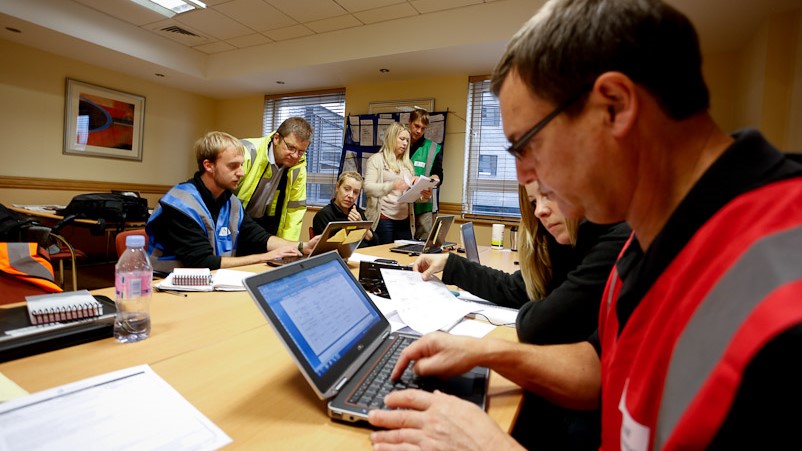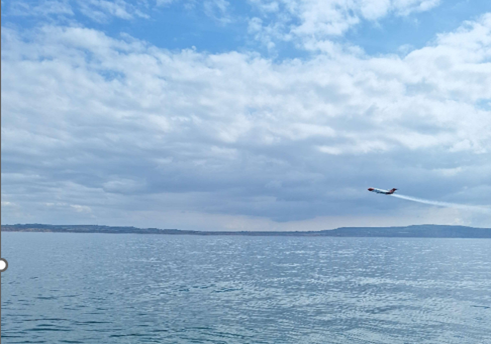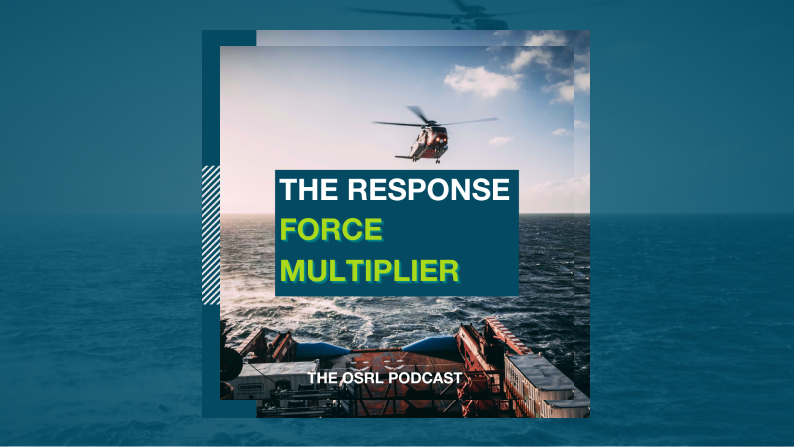Top Tips for What Makes a Great Exercise
"Russia’s military performance in Ukraine has highlighted that Russia’s military strategic exercises...have failed to sustain the military’s ability to conduct large scale, complex operations. Such events are heavily scripted, do not encourage initiative, and primarily aim to impress Russian leaders and international audiences"
This quote is from a piece carried by multiple newspapers last week. Over the years, we have attended many oil spill and other incident management exercises. Exercises can be the closest thing you're ever going to get to the real thing, and it's a chance to test your assumptions and understanding.
It can be a great team-building exercise and bring different functions of the company together in a meaningful and essential way.
The recent coverage of Russian exercises caused us to reflect on what makes a great exercise. So we asked Rob James, Commercial Director and Lee Barber, Preparedness Solutions Manager, what makes for a great exercise. Here are their top tips.
Exercise Fundamentals
Some fundamentals should form the basis of all exercises. Probably most important is defining the purpose and the objectives, followed very closely by setting the date. Setting the date and ensuring you've booked suitable facilities is essential. You get that bit right, and the rest is easy!
In our experience, the need to either test or train teams drives exercises. Consequently, the aim of the exercise forms the main objectives.
The objectives drive a lot of the content. It's crucial that you don't have too many. If you can, limit the objectives to between three and five. If you have more than that, your exercise will become overly complex.
The ipieca/IOGP Good Practice Guide provides guidance on constructing an exercise programme and is an invaluable resource.
So, What Works Well? Here Are Our Top Tips
Practise responding to realistic scenarios for continuous improvements
All exercises are typically scenario-based; if you have a scenario, make it a realistic one.
Make sure that the people who will be running an actual incident are in those roles for an exercise. Senior leaders often duck the exercise due to business or worries about loss of face if they make mistakes. Where those people make time, ensure they are fully versed in their role and are not afraid of feedback.
In the SIMCELL – it is essential to ensure key role players such as the vessel master or an OIM are played by those who have been in those roles or are still in them. It's such a technical role and so demanding in terms of the knowledge base that it's challenging to get it right. It makes such a difference to the exercise delegates to speak to somebody reacting as they would in real life.
You can also use the exercise to contact external stakeholders such as contractors, as it helps to bring a sense of realism about how long it will take to sign contracts, validate contact and mobilisation details and what the various blockers will be. It is important to be clear that it's an exercise.
One additional consideration. Role players don't always have to be in the SIMCELL. It depends on your objectives. We've seen SIMCELLs, which involved government entities in the past, and they worked well. However, the organisation was sufficiently mature in terms of its capability, so they felt it was okay to make a few mistakes in front of the regulator. It's maybe something you wouldn't perhaps do if you are beginning the road to building capability.
Field deployments are another way to add realism, either simultaneously or separately to the main exercise. Both have advantages and disadvantages. If you are still developing teams, separating the offshore exercise and running it beforehand is probably best. That way, you can give relative feedback on any incorrect assumptions, like "it'll be there in 5 minutes" or "yes, that piece of kit was maintained last week and is running smoothly".
Use actual data wherever possible — today's weather, freight availability, equipment readiness, and other relevant factors. The temptation to 'cheat' in an exercise can sometimes be overwhelming, but these are all constraints you will find in a real-world incident, so play them for real here. Note that one exception may be weather and currents if the exercise is to test a particular scenario in your plan.
Staging a press conference is fantastic for focusing the mind. It helps to drive the exercise when people know they will be fronting up to the cameras very shortly. It can help if the press conference is the very last session of the day because people are usually mentally exhausted by the end of it. Recording this session can help as it gives helpful material during feedback later, particularly if exercising your media management is an exercise objective.
Plan it well but don't share the plan
Exercise designers will try to weave several considerations into play. Elements to consider include:
- Check the capability.
- Are teams ready for the test phase?
- What are the priorities?
- Any complimentary activities?
- Mandatory/regulatory exercises?
- Rota issues? Ensure equal experiences?
- Onboard new team members?
Critical to a good exercise is a dedicated team running the exercise, who have planned it well and have injects ready to feed in to keep the pace high is critical. However, there is no need for those participating, including those at a senior level, to know that plan in advance.
Don't be afraid to have time jumps but use them carefully
Most incidents generate a tremendous amount of information and require several discussions and decisions. This quantity is hard to replicate in an exercise if you include a time jump. There is the potential for the exercise to become confusing. People may struggle to determine the decisions made and the current state of the 'incident'.
Whether an exercise has a time jump depends on the objective and the parts of the plan you need to exercise. It may be necessary to have some time jumps in your drill. If a time jump is required, use time jumps wisely and don't use them to magically solve an unresolved issue from earlier in the exercise.
There's no such thing as a bad exercise, just bad follow-up
There's no getting away from the fact that there's very little point in testing the system if the organisation fails to learn and repeats the same mistake.
Keep the debrief reasonably short. People are usually tired after the exercise and their brains can be frazzled. The tried and tested system of "three good points and three points for improvement" seems to work well.
Capturing the real-time feedback points on a screen can save much time and minimise misunderstanding as everybody gets to see the feedback as it's written, which can then go into the main report. If you can - hold a post-exercise workshop to develop and endorse an action plan.
Testing the ‘Hearts and Minds’ approach can bring huge rewards
Community liaison and engagement have always been important. It is critical to get the local community on your side, work collaboratively with them, communicate with them, and, most significantly, reassure them that you are conducting the pollution response responsibly.
Leaving an indelible positive mark on the community is crucial to your response. The 'hearts and minds' approach may sound contrived, but it's as critical to a successful response as a clean beach. It is essential to factor this into your exercise planning and testing.
Discovering the ‘Unknowns’
To quote Donald Rumsfeld, "We know, there are known knowns; there are things we know we know. We also know there are known unknowns; that is to say, we know there are some things we do not know."
Donald Rumsfeld's very famous quote about unknowns is significant in exercises. There are lots of unknown issues which may challenge us during a response; sometimes known and sometimes unknown. Identifying these unknowns could mean the difference between doing it right and wrong, as our following example shows.
'Unknown unknowns' came up during an offshore exercise in Libya. The exercise objective was to test the team's ability to deploy the containment and recovery equipment. This activity was something the offshore team had done for years without any problems. They had gone without a hitch, but for one key reason – the exercises were just for show and didn’t test the whole system. Once the team changed their approach, they found lots of issues that would have caused real issues during an incident, vessels were too small, hoses were too short, and connectors didn’t connect!
The team made a few recommendations, and the next time they attended the deployment, they had fixed the issues, meaning they were much more able to contain and recover the oil effectively.
Throughout exercises, you should always ask yourself:
How am I handling those known unknowns and unknown unknowns? Do I need a different viewpoint?
Which Factors Limit The Effectiveness of an Exercise?
When focus becomes tunnel vision
Tunnel vision might be a problem during incidents, but can be tested during exercises. In 1995 Kenneth Conley, a Boston police officer, was convicted of perjury and obstruction because he'd been chasing a suspect and hadn't noticed a group of policemen beating someone up even though he ran right past them just a few metres away.
There's a lot more to the story, but the critical point is that Conley swore in court that he didn't see the fight, so the jury decided he must have been lying. However, a researcher by the name of Chris Chabris put the alibi to the test and conducted his experiments. He asked volunteers to follow somebody jogging and count the number of times the person touched their head as they jogged. Many of them didn't know there was a staged fight in broad daylight right next to the path. 40% of those following the jogger didn't see the staged fight, and Chris Chabris proved it was plausible that police officer Kenneth Conley had suffered inattentional blindness.
In another example of tunnel vision, some years back, the French train company SNCF fell victim to the challenges of technology. They were running an exercise and testing aspects of media management. This scenario was a deadly train incident involving the tragic loss of life of many people.
SNCF was so focused on communicating that they put the details on their website. They didn't realise this website was published and available to the public. Without the words ‘exercise’ in bold throughout the copy, it was unclear that the exercise was not an actual incident. Only when they started to get calls from real journalists did it become clear they had made a mistake.
“Any intelligent fool can make things bigger, more complex, and more violent. It takes a touch of genius — and a lot of courage to move in the opposite direction.”
Some exercises try to be overambitious with too many objectives. The exercise attempts to drive forward with levels of complexity that overwhelm the attendees.
One such exercise in Jakarta proved that point when the teams were working with a particular software platform that was 'all consuming' and demanded a lot of brain power. The scenario included a deliberate safety problem for them to solve, but nobody seemed to be able to decide to stop the response.
During the debrief, we discussed this point, but the exercise participants felt too busy trying to complete the tasks contained within the software. If this had been an actual event, it could have resulted in the loss of lives.
It is much better if you can limit the number of objectives to a manageable level (i.e. five) and try to make them complementary, such as testing the interaction between industry and government and your media response.
Virtual exercises bring their levels of complexity. Organisations should have their processes in order before conducting a virtual exercise, as these virtual platforms can amplify poor processes.
Virtual exercises open possibilities but add complexity
A wide variety of communication platforms exist in any virtual exercise. There can be too many platforms, resulting in a situation where the cart is leading the donkey.
There is the central platform, i.e., MS Teams or Zoom, which are very useful in terms of functionality. Some groups mistakenly treat these platforms like a glorified conference call and don't take advantage of the various functions such as the breakout rooms, group announcements and file storage facilities.
In addition to the central platform, there can be WhatsApp groups for SIM cell people, telephone calls, conference calls, VHF radio for field deployments, emails, texts and many more. So much communication can quickly be overwhelming for those involved.
Good IT is critical. Most people need at least two screens to cope with the various platforms. Sound quality during calls is important - headsets are an advantage, and if you lose your connection, you need an outstanding deputy who can pick up where you dropped off at a moment's notice.
A virtual IMS facilitator is a new essential function within the ICS or IMS organisation. This function is needed so they can run all the IT elements and take the pressure off the planning section chief. There are many issues this function will need to take care of, such as people appearing in breakout rooms where they shouldn't be, some people not muting, bringing background noise, and disrupting communications.
Whilst the breakout rooms are excellent; there is a tendency towards the silo effect - information by osmosis doesn't work. Observing everything is challenging; the Information Centre is critical - you need to record actions/ timelines/ decisions and monitor costs. Teams can forget this data capture in a virtual exercise.
During a virtual exercise, it is likely that participants could suffer from screen fatigue as users are likely to be focusing on those multiple screens. It can be mentally exhausting being constantly on the go. Long exercises are ambitious, so it's essential to make sure you look after your teams, take breaks, and get some fresh air between meetings.
Conclusion
Going into an exercise, maybe we should ask ourselves “are we exercising to impress, as was reported about the Russian military, or our we exercising to learn?”
Exercises are about as close to the real thing as it gets and they are a vital component in the preparedness toolbox to ensure the system is tested so that gaps can be exposed and improved. There are several styles of exercises that can be employed to suit the needs of the organisation, and being clear on the objectives is key. It is important to use realistic scenarios and experienced people to drive the exercise forward by using realistic phone calls, emails, and other relevant inputs, it can be a wasted opportunity if thoughts, ideas and knowledge aren’t stretched and tested in peacetime.
In our experience exercises always generate learnings, which if acted upon will serve to improve preparedness and thereby mitigate the number of challenges that a real incident will bring, it is important to consider though with each subsequent exercise how the team can be stretched and uncover some of the unknows which exist in every organisation. The important point to remember is to not make exercises overly complex, but to stick to reality, i.e. if you would use MS Teams during an incident, then test that system during an exercise and don’t be afraid to challenge thoughts and status quo if the exercise reveals that there is a better way of doing it!
Need to test and improve your preparedness and response capability?
Well designed exercises test response capabilities including plans, people, equipment and systems. Develop your exercise and planning programme today or join us in one of our scheduled exercises!








